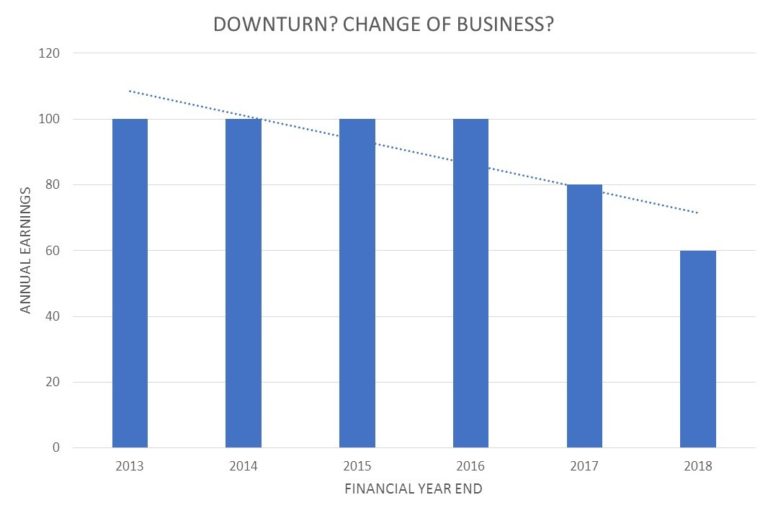Earnings and value
Earnings drive value. Value is a function of earnings. But what level of earnings should be used in the valuation? The key is the sustainability of earnings. How sustainable are earnings? What are the core underlying earnings?
In the capitalisation of future maintainable earnings method, maintainable earnings represent an estimate of the annual earnings of the business which are likely to be achievable on an ongoing basis.*
Historical earnings may be relevant, but only if the business is expected to continue in exactly the same way. If the business is eliminating operations or adding new operations this needs to be reflected in the earnings.
In assessing earnings, consideration needs to be given to the key value drivers of the business, such as:
- changes in products and services
- changes in customers and suppliers
- changes in prices and costs of goods and services
- changes in competition and the company’s competitive advantage
- changes in technology
Earnings Trend
It is imperative the trend in historical earnings is understood. Are earnings flat, trending up, trending down? Do earnings have a cyclical pattern, are they dependent on cyclical events? What is the cause of the earnings trend? Is the trend set to continue and why?

The chart above shows the business had good consistent earnings in the four years to 2016. Are these earnings a good indicator of future earnings?
In the current 2017 financial year, earnings have declined. The forecast for 2018 is for a further significant reduction.
The company is going through significant turmoil. Developments in technology have allowed a wave of new, young and disruptive competitors. The future of the company is in doubt. Historical earnings aren’t a good indicator of future earnings.

The above chart shows exactly the same historical, stable earnings performance. In the current 2017 year earnings have started to increase and earnings are expected to further increase in 2018.
The company has embraced new technology developments which has allowed it to access new customer markets.
Cyclical earnings

Is a fluctuations in earnings a genuine shift in the business? Or are the movements as a result of cyclical customers? The graph above shows earnings improved each year from 2013 to 2015, but then significantly dropped in 2016. The reason is the business provides conference facilities to events. Some of the key events they supply to are every two years and some every three years. As a result earnings fluctuate significantly depending on the year the events are on.
Earnings understood
Has revenue increased due to increases in prices? Have the number of sales transactions declined? What are the future implications of higher prices – more lost customers?
Are earnings increasing due to cost efficiencies? If so, can these cost efficiencies continue? Are there any negative side affects of cost efficiencies? For example, reducing sales and marketing costs could negatively impact future sales. Have costs been reduced because senior and important staff have left, which will impact operations and earnings in the future.

The chart above shows the movement between earnings in 2015 and earnings in 2017. The blue blocks shows key earning drivers where improvements have been made. The company has increased prices and reduced product, marketing, salary and office costs.
One consequence of increasing prices is a reduction in customers. Which has happened. What is the reason for the increase in the price – higher quality product or better customer service? Yet product costs have declined. Is the company now buying cheaper, inferior products. If so, this could have serious negative impacts on future earnings.
Reducing marketing could also have a negative impact on attracting and retaining customers and so lead to lower earnings. Why have salary costs decreased? Due to improvements in productivity? Or have key staff left (and joined competitors or set up in competition? Or have individual salaries been reduced, which could lead to future motivational problems?
Monthly earnings
How are monthly earnings tracking? What is the monthly earnings trend? How do monthly earnings compare to the same month last year?

The above chart shows that monthly earnings have improved toward the end of the 2016 financial year. Good.
Up until April, monthly earnings in 2016 were similar to monthly earnings in 2015. Why have earnings surged, compared to 2015, in the last three months of 2015? Is there a bone-fide explanation that will drive sustainble earnings growth? Or has 2017 revenue simply been aggressively brought forward into the 2017 account?
Forecast earnings
How are earnings tracking compared to forecast earnings? On track? How successful have the management team been reaching forecasts? Does the company typically meet or beat forecasts or are forecasts traditionally woefully optimistic? What is the forecast for next year? How valid are the forecast assumptions?

The above chart shows annual forecast earnings against actual results. The management team have consistently over estimated future earnings. That optimism has increased as the company has grown. The gap between forecast earnings and actual earnings has increased. Management forecasts have proved not to be reliable in judging future earnings.
Simon is a CA Business Valuation specialist in Brisbane, Chartered Accountant and a Certified Fraud Examiner. Simon specialises in providing business valuation services. Prior to founding Lotus Amity, he was a Corporate Finance and Forensic Accounting partner with BDO Australia. Simon provides valuation services in disputes, for raising finance, for restructuring, transactions and for tax purposes.


